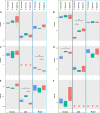Sequence Evolution and Expression of the Androgen Receptor and Other Pathway-Related Genes in a Unisexual Fish, the Amazon Molly, Poecilia formosa, and Its Bisexual Ancestors
- PMID: 27249369
- PMCID: PMC4889153
- DOI: 10.1371/journal.pone.0156209
Sequence Evolution and Expression of the Androgen Receptor and Other Pathway-Related Genes in a Unisexual Fish, the Amazon Molly, Poecilia formosa, and Its Bisexual Ancestors
Abstract
The all-female Amazon molly (Poecilia formosa) originated from a single hybridization of two bisexual ancestors, Atlantic molly (Poecilia mexicana) and sailfin molly (Poecilia latipinna). As a gynogenetic species, the Amazon molly needs to copulate with a heterospecific male, but the genetic information of the sperm-donor does not contribute to the next generation, as the sperm only acts as the trigger for the diploid eggs' embryogenesis. Here, we study the sequence evolution and gene expression of the duplicated genes coding for androgen receptors (ars) and other pathway-related genes, i.e., the estrogen receptors (ers) and cytochrome P450, family19, subfamily A, aromatase genes (cyp19as), in the Amazon molly, in comparison to its bisexual ancestors. Mollies possess-as most other teleost fish-two copies of the ar, er, and cyp19a genes, i.e., arα/arβ, erα/erβ1, and cyp19a1 (also referred as cyp19a1a)/cyp19a2 (also referred to as cyp19a1b), respectively. Non-synonymous single nucleotide polymorphisms (SNPs) among the ancestral bisexual species were generally predicted not to alter protein function. Some derived substitutions in the P. mexicana and one in P. formosa are predicted to impact protein function. We also describe the gene expression pattern of the ars and pathway-related genes in various tissues (i.e., brain, gill, and ovary) and provide SNP markers for allele specific expression research. As a general tendency, the levels of gene expression were lowest in gill and highest in ovarian tissues, while expression levels in the brain were intermediate in most cases. Expression levels in P. formosa were conserved where expression did not differ between the two bisexual ancestors. In those cases where gene expression levels significantly differed between the bisexual species, P. formosa expression was always comparable to the higher expression level among the two ancestors. Interestingly, erβ1 was expressed neither in brain nor in gill in the analyzed three molly species, which implies a more important role of erα in the estradiol synthesis pathway in these tissues. Furthermore, our data suggest that interactions of steroid-signaling pathway genes differ across tissues, in particular the interactions of ars and cyp19as.
Conflict of interest statement
Figures




Similar articles
-
Allele-specific expression at the androgen receptor alpha gene in a hybrid unisexual fish, the Amazon molly (Poecilia formosa).PLoS One. 2017 Oct 12;12(10):e0186411. doi: 10.1371/journal.pone.0186411. eCollection 2017. PLoS One. 2017. PMID: 29023530 Free PMC article.
-
The gonadal transcriptome of the unisexual Amazon molly Poecilia formosa in comparison to its sexual ancestors, Poecilia mexicana and Poecilia latipinna.BMC Genomics. 2018 Jan 3;19(1):12. doi: 10.1186/s12864-017-4382-2. BMC Genomics. 2018. PMID: 29298680 Free PMC article.
-
Comparative analysis of the gonadal transcriptomes of the all-female species Poecilia formosa and its maternal ancestor Poecilia mexicana.BMC Res Notes. 2014 Apr 17;7:249. doi: 10.1186/1756-0500-7-249. BMC Res Notes. 2014. PMID: 24742317 Free PMC article.
-
Dispensable and indispensable genes in an ameiotic fish, the Amazon molly Poecilia formosa.Cytogenet Cell Genet. 1998;80(1-4):193-8. doi: 10.1159/000014979. Cytogenet Cell Genet. 1998. PMID: 9678357 Review.
-
Genes encoding aromatases in teleosts: evolution and expression regulation.Gen Comp Endocrinol. 2014 Sep 1;205:151-8. doi: 10.1016/j.ygcen.2014.05.008. Epub 2014 May 20. Gen Comp Endocrinol. 2014. PMID: 24859258 Review.
Cited by
-
Chronic exposure to aquacultural stressors affects pituitary-testis axis in the Mozambique tilapia Oreochromis mossambicus.Fish Physiol Biochem. 2022 Apr;48(2):437-448. doi: 10.1007/s10695-022-01061-9. Epub 2022 Feb 24. Fish Physiol Biochem. 2022. PMID: 35201519
-
Transcriptomic analysis of female and male gonads in juvenile snakeskin gourami (Trichopodus pectoralis).Sci Rep. 2020 Mar 23;10(1):5240. doi: 10.1038/s41598-020-61738-0. Sci Rep. 2020. PMID: 32251302 Free PMC article.
-
Allele-specific expression at the androgen receptor alpha gene in a hybrid unisexual fish, the Amazon molly (Poecilia formosa).PLoS One. 2017 Oct 12;12(10):e0186411. doi: 10.1371/journal.pone.0186411. eCollection 2017. PLoS One. 2017. PMID: 29023530 Free PMC article.
-
The gonadal transcriptome of the unisexual Amazon molly Poecilia formosa in comparison to its sexual ancestors, Poecilia mexicana and Poecilia latipinna.BMC Genomics. 2018 Jan 3;19(1):12. doi: 10.1186/s12864-017-4382-2. BMC Genomics. 2018. PMID: 29298680 Free PMC article.
References
-
- Mayr E. Animal species and evolution Cambridge: Harvard University Press; 1963.
MeSH terms
Substances
LinkOut - more resources
Full Text Sources
Other Literature Sources
Research Materials

